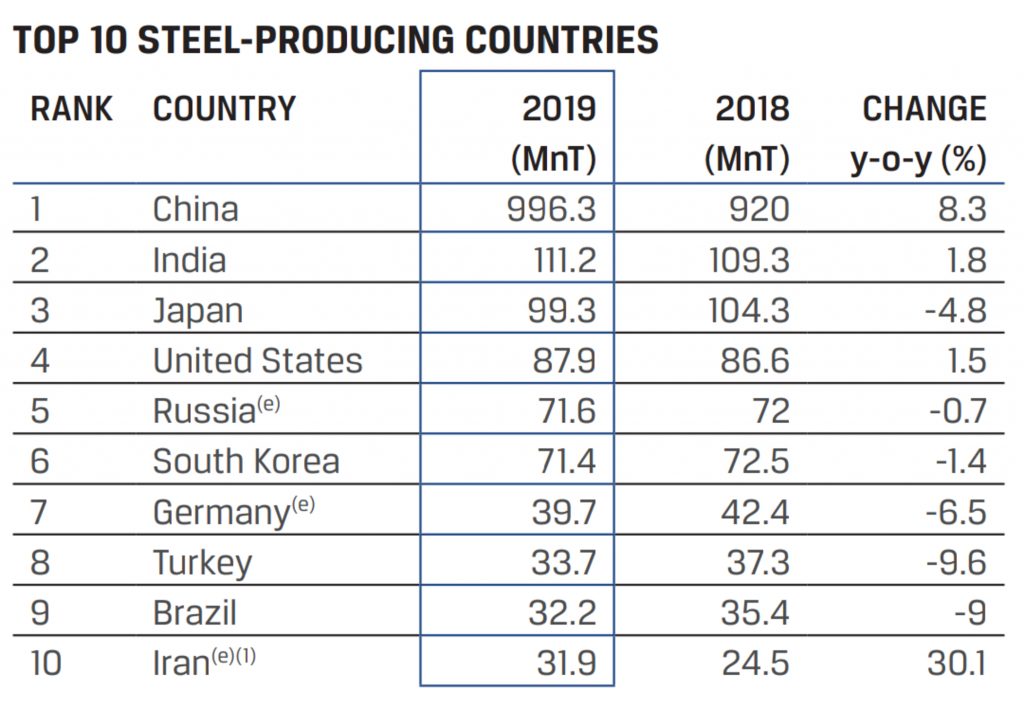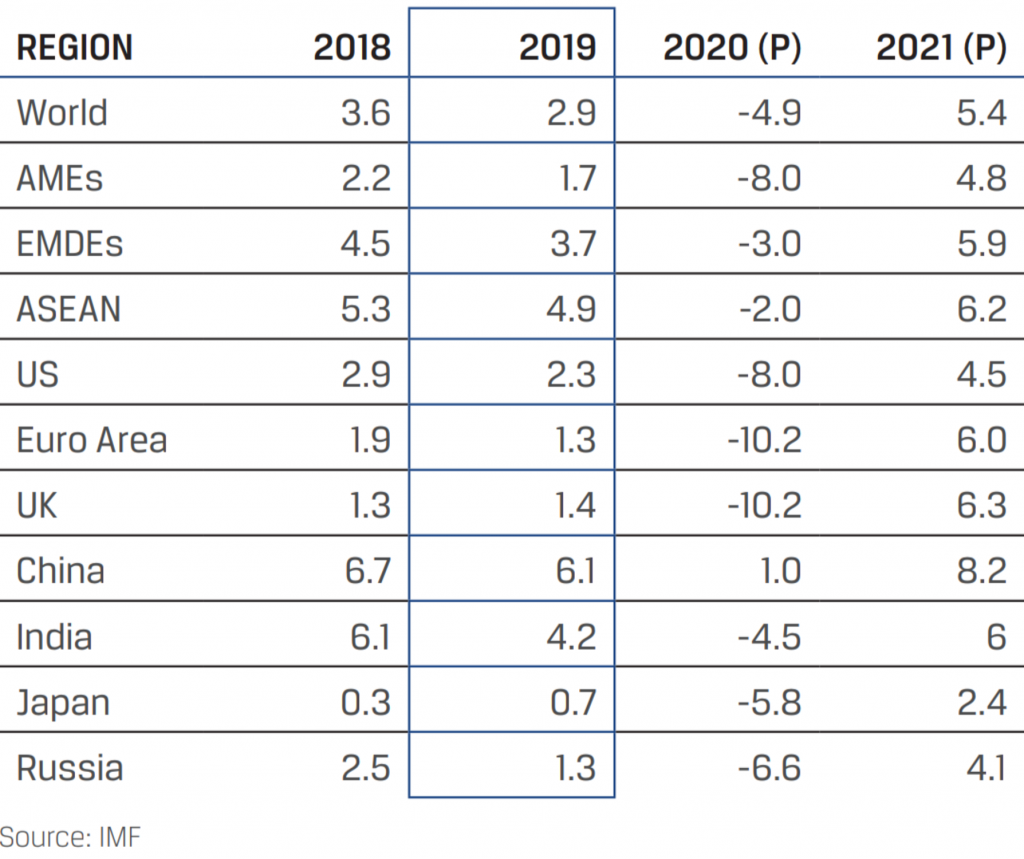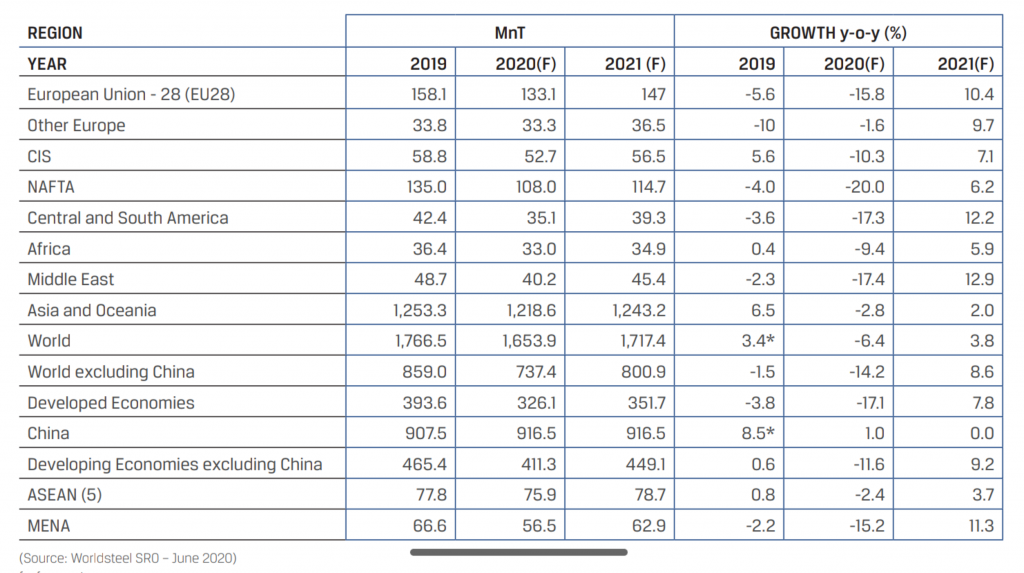Here You can see about Global Steel Industry. China continued to be the world’s largest steel producer with increase in production by 8.3% to reach 996 MnT. China contributed to 53% of the global crude steel production in 2019.

Global Steel Industry
Global crude steel production in 2019 saw a growth of 3.4% over 2018 to reach 1,869.69 MnT. This increase was primarily due to the growth in steel consumption in infrastructure, manufacturing, and equipment sectors.
The automotive production trended down across most countries over the second half of 2019 which had an impact on the steel demand towards the end of the year.
While steel demand remained relatively strong, the country faced significant downside risks due to broader global uncertainty and tighter environmental
regulations.
In United States, crude steel production went up to 88 MnT, recording an increase of 1.5% over 2018, owing to lower global automotive production and prevailing trade tensions.
In Japan, steel consumption declined largely due to a slowdown in manufacturing during 2019. The country produced 99 MnT of crude steel last year, a decrease of 4.8% compared to 2018.

In Europe, crude steel production slumped to 159 MnT in 2019, recording a decrease
of 4.9% over 2018. The decrease was on account of challenges faced with oversupply and trade tensions.
In 2019, India became the second largest crude steel producing country in the world, with a crude steel production of 111 MnT, an increase of 1.8% over the previous year. However, the growth rate was much lower compared to the previous year.
Growth in the construction sector weakened due to falling investments in fixed asset formation. Sharp fall in the private consumption led to weaker growth in automotive and consumer durables.
The tighter liquidity conditions due to defaults in NBFC sector impacted credit availability in iron and steel industry.
The automotive sector was also impacted by factors such as regulatory changes, rise in ownership cost, and shared economy while, the capital goods sector continued to remain weak due to the decreasing output and stagnant investment in the manufacturing sector.
Outlook for Steel Industry
The COVID-19 pandemic has severely affected economies and industries globally and the steel industry is no exception. Here is the Global Steel Industry Outlook
Therefore, outlook for the steel industry includes scenarios regarding the pandemic’s speed of propagation, possible recurrence, near-term impact of measures being taken to contain the outbreak, and the effectiveness of the stimulus announced by the Governments of various nations.
Global Steel Industry Outlook: After slower than expected growth in 2019, steel demand is estimated to contract significantly in the Financial Year 2020-21. According to the World Steel Association (‘WSA’), it is possible that the impact on steel demand in relation to the expected contraction in GDP may turn out to be less severe than that seen during the erstwhile global financial crisis.

In comparison with other sectors, the manufacturing sector is expected to rebound quicker though supply chain disruptions are likely to continue. Most of the steel producing regions are expected to witness a decline in crude steel output due to production cuts amidst ongoing lockdowns.
Global Steel Industry Outlook However, it is expected that compared to other countries, China will move faster towards normalization of economic activity as it was the first country to come out of the COVID-19 crisis.
Governments of different nations have announced sizeable stimulus packages
which are expected to favour steel consumption through investment in infrastructure and other incentives for the steel industry.
Global Steel Industry Outlook In India, muted demand and oversupply is likely to result in suppressed steel prices and capacity utlisation in the near term. Since India depends largely on migrant labour, restarting construction and infrastructure projects will be a challenge.
The demand from infrastructure, construction, and real estate sectors is likely to be subdued in the first half of the Financial Year 2020-21 due to the lockdown during the first quarter followed by the monsoons during the second quarter.
Global Steel Industry Outlook Further, the demand from automobile, white goods, and capital goods sectors is likely to reduce significantly with consumers deferring discretionary spends in the near term. Effective government stimulus and return of consumer confidence is likely to be the key driver for a gradual recovery over the second half of the Financial Year 2020-21.
The global steel industry faced a challenging CY 2019, as demand growth in a few markets was largely offset by declines in the rest of the world. An uncertain economic
environment, coupled with continued trade tensions, slowdown in global manufacturing notably auto sector and intensifying geopolitical issues, weighed on investment and trade.
Global Steel Industry Outlook Similarly, production growth was only visible in Asia and the Middle East and to some extent in the US, while the rest of the world witnessed a contraction.

CRUDE STEEL PRODUCTION
Global crude steel output in CY 2019 grew by 3.4% y-o-y to 1,869.9 MnT.
The global steel industry faced pricing pressure for most parts of CY 2019, in the wake of a protective market environment in key economies, including the imposition of Section 232 in the US.
This was further aggravated due to country-specific demand slowdown, that fuelled
market imbalances. In line with a conservative trade sentiment, consumer industries of steel undertook active destocking.
This led to stunted capacity utilisation and resulted in net excess capacity globally. This was further complemented by addition of new capacities and resulted in downward pressure on steel prices.
UPDATE ON KEY MARKETS
China: Leading the steel industry
Chinese demand and production levels constitute more than half the global steel industry, making world steel trade significantly reliant on demand-supply drivers of the country’s economy.
In CY 2019, China produced 996.3 MnT of crude steel, up 8.3% y-o-y; demand for finished steel products was estimated at 907.5 MnT, up 8.6% y-o-y.
Steel demand for real estate remained buoyant, due to strong growth in Tier-II, Tier-III and Tier-IV markets, led by relaxed controls. However, the growth was partially offset by muted auto sector performance.
EU28: Muted trade but outlook positive
The Eurozone was hit hard in CY 2019 by trade uncertainties due to a sharp slowdown in German manufacturing led by lower exports. Demand for finished steel products fell 5.6% y-o-y, due to the weakness in the automotive sector, which was partially offset by a resilient construction sector.
Crude steel production declined 4.9% y-o-y to 159.4 MnT from 167.7 MnT.
Steel Industry in US: Flattish growth
Demand for finished steel products in the US grew by 1.0% y-o-y to 100.8 MnT from 99.8 MnT.
Japan: Sluggish demand amid signs of gradual recovery Notwithstanding the new sales tax regime, the Japanese economy is expected to recover gradually, supported by easing monetary policy and public investments, which is likely to support steel consumption growth in the short term.
Further, Japan being an export-driven economy stands to benefit from the resolution of trade disputes. However, overall demand for steel is expected to contract slightly,
on account of a weak global macroeconomic environment.
Demand for finished steel products in Japan fell by 1.4% y-o-y to 64.5 MnT in CY 2019 from 65.4 MnT.
OUTLOOK For Global Steel Industry
The World Steel Association (worldsteel) forecasts steel demand to decline by 6.4% y-o-y to 1,654 MnT in CY 2020, due to the COVID-19 impact.
However, it has asserted that the global steel demand could rebound to 1,717 MnT in CY 2021 and witness a 3.8% rise on a y-o-y basis. Chinese demand is likely to recover faster than in the rest of the world.
The forecast assumes that lockdown measures will be eased by June and July, with social distancing continuing and major steelmaking countries not witnessing a second
wave of the pandemic.
Steel demand is expected to decline sharply across most countries, especially in the second quarter of CY 2020, with a likely gradual recovery from the third quarter. However, risks to the forecast remain on the downside as economies make a graded exit from the lockdowns, without any particular cure or vaccine for COVID-19.
Chinese steel demand is expected to grow by 1% y-o-y in CY 2020, with improved outlook for CY 2021, given that it was the first country to lift the lockdown (February
2020). By April, its construction sector had achieved 100% capacity utilisation.
Developed economies
Steel demand in developed economies are expected to decline 17.1% y-o-y in CY 2020, due to the COVID-19 impact with businesses struggling to stay afloat and high
unemployment levels.
Thus, recovery in CY 2021 is expected to be muted at 7.8% y-o-y. Steel demand recovery in the EU markets is likely to get delayed beyond CY 2020. The US market is also likely to witness a slight recovery in CY 2021.
Meanwhile, Japanese and Korean steel demand will witness double-digit declines in CY 2020, with Japan being impacted by reduced exports and halted investments in automobiles and machinery sectors, and Korea being impacted by lower exports and weak domestic industry.
Developing economies (excluding China)
Steel demand in developing countries excluding China is expected to decline by 11.6% in CY 2020, followed by a 9.2% recovery in CY 2021.

